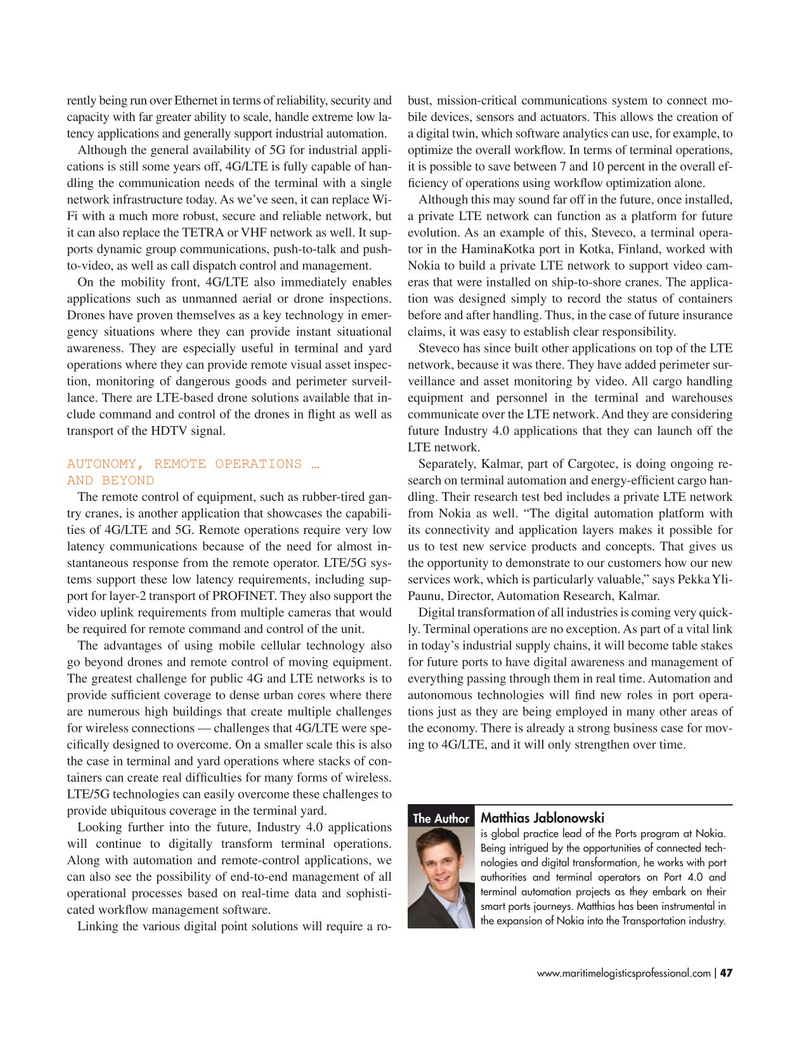
Page 47: of Maritime Logistics Professional Magazine (Jul/Aug 2019)
Breakbulk Issue
Read this page in Pdf, Flash or Html5 edition of Jul/Aug 2019 Maritime Logistics Professional Magazine
rently being run over Ethernet in terms of reliability, security and bust, mission-critical communications system to connect mo- capacity with far greater ability to scale, handle extreme low la- bile devices, sensors and actuators. This allows the creation of tency applications and generally support industrial automation. a digital twin, which software analytics can use, for example, to
Although the general availability of 5G for industrial appli- optimize the overall work? ow. In terms of terminal operations, cations is still some years off, 4G/LTE is fully capable of han- it is possible to save between 7 and 10 percent in the overall ef- dling the communication needs of the terminal with a single ? ciency of operations using work? ow optimization alone. network infrastructure today. As we’ve seen, it can replace Wi- Although this may sound far off in the future, once installed,
Fi with a much more robust, secure and reliable network, but a private LTE network can function as a platform for future it can also replace the TETRA or VHF network as well. It sup- evolution. As an example of this, Steveco, a terminal opera- ports dynamic group communications, push-to-talk and push- tor in the HaminaKotka port in Kotka, Finland, worked with to-video, as well as call dispatch control and management. Nokia to build a private LTE network to support video cam-
On the mobility front, 4G/LTE also immediately enables eras that were installed on ship-to-shore cranes. The applica- applications such as unmanned aerial or drone inspections. tion was designed simply to record the status of containers
Drones have proven themselves as a key technology in emer- before and after handling. Thus, in the case of future insurance gency situations where they can provide instant situational claims, it was easy to establish clear responsibility. awareness. They are especially useful in terminal and yard Steveco has since built other applications on top of the LTE operations where they can provide remote visual asset inspec- network, because it was there. They have added perimeter sur- tion, monitoring of dangerous goods and perimeter surveil- veillance and asset monitoring by video. All cargo handling lance. There are LTE-based drone solutions available that in- equipment and personnel in the terminal and warehouses clude command and control of the drones in ? ight as well as communicate over the LTE network. And they are considering transport of the HDTV signal. future Industry 4.0 applications that they can launch off the
LTE network.
Separately, Kalmar, part of Cargotec, is doing ongoing re-
AUTONOMY, REMOTE OPERATIONS …
AND BEYOND search on terminal automation and energy-ef? cient cargo han-
The remote control of equipment, such as rubber-tired gan- dling. Their research test bed includes a private LTE network try cranes, is another application that showcases the capabili- from Nokia as well. “The digital automation platform with ties of 4G/LTE and 5G. Remote operations require very low its connectivity and application layers makes it possible for latency communications because of the need for almost in- us to test new service products and concepts. That gives us stantaneous response from the remote operator. LTE/5G sys- the opportunity to demonstrate to our customers how our new tems support these low latency requirements, including sup- services work, which is particularly valuable,” says Pekka Yli- port for layer-2 transport of PROFINET. They also support the Paunu, Director, Automation Research, Kalmar.
video uplink requirements from multiple cameras that would Digital transformation of all industries is coming very quick- be required for remote command and control of the unit. ly. Terminal operations are no exception. As part of a vital link
The advantages of using mobile cellular technology also in today’s industrial supply chains, it will become table stakes go beyond drones and remote control of moving equipment. for future ports to have digital awareness and management of
The greatest challenge for public 4G and LTE networks is to everything passing through them in real time. Automation and provide suf? cient coverage to dense urban cores where there autonomous technologies will ? nd new roles in port opera- are numerous high buildings that create multiple challenges tions just as they are being employed in many other areas of for wireless connections — challenges that 4G/LTE were spe- the economy. There is already a strong business case for mov- ci? cally designed to overcome. On a smaller scale this is also ing to 4G/LTE, and it will only strengthen over time.
the case in terminal and yard operations where stacks of con- tainers can create real dif? culties for many forms of wireless.
LTE/5G technologies can easily overcome these challenges to provide ubiquitous coverage in the terminal yard.
Matthias Jablonowski
The Author
Looking further into the future, Industry 4.0 applications is global practice lead of the Ports program at Nokia. will continue to digitally transform terminal operations.
Being intrigued by the opportunities of connected tech-
Along with automation and remote-control applications, we nologies and digital transformation, he works with port authorities and terminal operators on Port 4.0 and can also see the possibility of end-to-end management of all terminal automation projects as they embark on their operational processes based on real-time data and sophisti- smart ports journeys. Matthias has been instrumental in cated work? ow management software. the expansion of Nokia into the Transportation industry.
Linking the various digital point solutions will require a ro- www.maritimelogisticsprofessional.com 47
I

 46
46

 48
48
